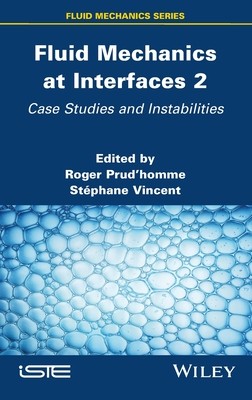
- We will send in 10–14 business days.
- Author: Roger Prudhomme
- Publisher: Wiley-ISTE
- ISBN-10: 1786308177
- ISBN-13: 9781786308177
- Format: 15.6 x 23.4 x 1.1 cm, hardcover
- Language: English
- SAVE -10% with code: EXTRA
Reviews
Description
Interfaces are present in most fluid mechanics problems. They not only denote phase separations and boundary conditions, but also thin flames and discontinuity waves. Fluid Mechanics at Interfaces 2 examines cases that involve one-dimensional or bi-dimensional manifolds, not only in gaseous and liquid physical states but also in subcritical fluids and in single- and multi-phase systems that may be pure or mixed.
Chapter 1 addresses certain aspects of turbulence in discrete mechanics, briefly describing the physical model associated with discrete primal and dual geometric topologies before focusing on channel flow simulations at turbulence-inducing Reynolds numbers. Chapter 2 centers on atomization in an accelerating domain. In one case, an initial Kelvin-Helmholtz instability generates an acceleration field, in turn creating a Rayleigh-Taylor instability which ultimately determines the size of the droplets formed. Chapter 3 explores numerical studies of pipes with sudden contraction using OpenFOAM, and focuses on modeling that will be useful for engines and automobiles.
Chapters 4 and 5 study the evaporation of droplets that are subject to high-frequency perturbations, a possible cause of instabilities in injection engines. The Heidmann model, which replaces the droplets in motion in a combustion chamber with a single continuously-fed droplet, is made more complex by considering the finite conduction heat transfer phenomenon. Finally, Chapter 6 is devoted to a study of the rotor blade surface of a Savonius wind turbine, considering both a non-stationary and a three-dimensional flow.
EXTRA 10 % discount with code: EXTRA
The promotion ends in 19d.23:33:25
The discount code is valid when purchasing from 10 €. Discounts do not stack.
- Author: Roger Prudhomme
- Publisher: Wiley-ISTE
- ISBN-10: 1786308177
- ISBN-13: 9781786308177
- Format: 15.6 x 23.4 x 1.1 cm, hardcover
- Language: English English
Interfaces are present in most fluid mechanics problems. They not only denote phase separations and boundary conditions, but also thin flames and discontinuity waves. Fluid Mechanics at Interfaces 2 examines cases that involve one-dimensional or bi-dimensional manifolds, not only in gaseous and liquid physical states but also in subcritical fluids and in single- and multi-phase systems that may be pure or mixed.
Chapter 1 addresses certain aspects of turbulence in discrete mechanics, briefly describing the physical model associated with discrete primal and dual geometric topologies before focusing on channel flow simulations at turbulence-inducing Reynolds numbers. Chapter 2 centers on atomization in an accelerating domain. In one case, an initial Kelvin-Helmholtz instability generates an acceleration field, in turn creating a Rayleigh-Taylor instability which ultimately determines the size of the droplets formed. Chapter 3 explores numerical studies of pipes with sudden contraction using OpenFOAM, and focuses on modeling that will be useful for engines and automobiles.
Chapters 4 and 5 study the evaporation of droplets that are subject to high-frequency perturbations, a possible cause of instabilities in injection engines. The Heidmann model, which replaces the droplets in motion in a combustion chamber with a single continuously-fed droplet, is made more complex by considering the finite conduction heat transfer phenomenon. Finally, Chapter 6 is devoted to a study of the rotor blade surface of a Savonius wind turbine, considering both a non-stationary and a three-dimensional flow.


Reviews